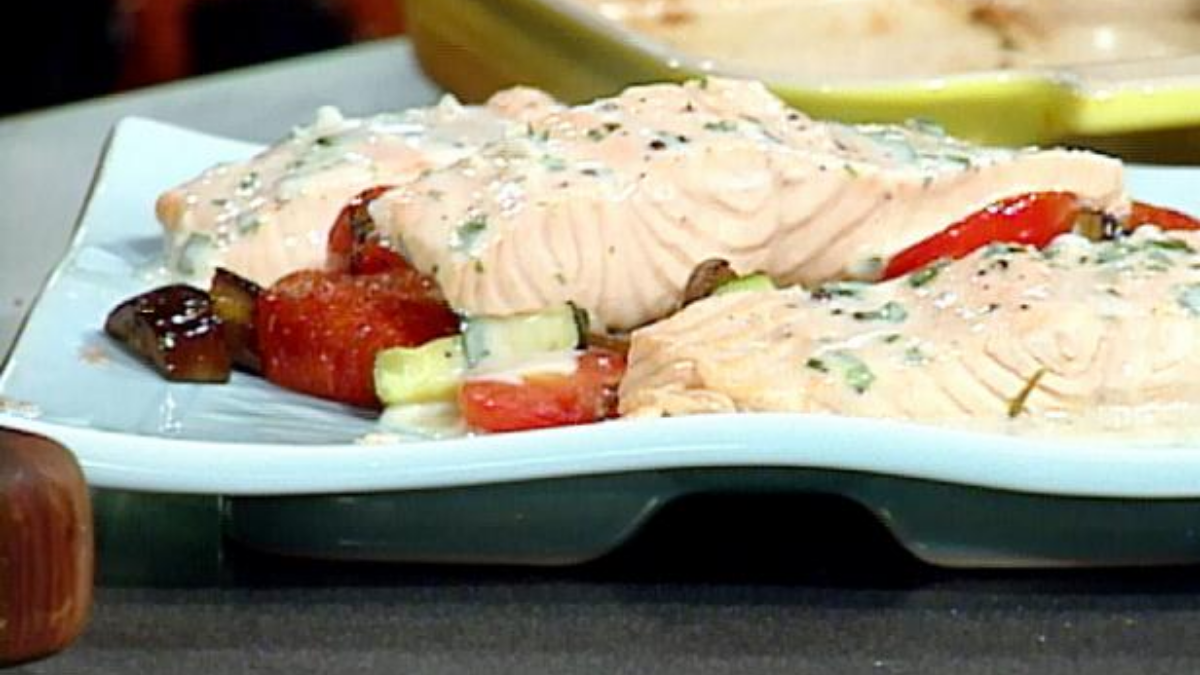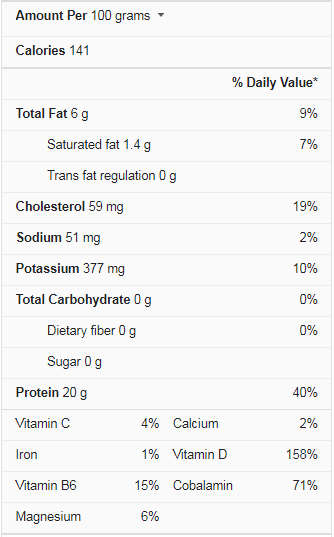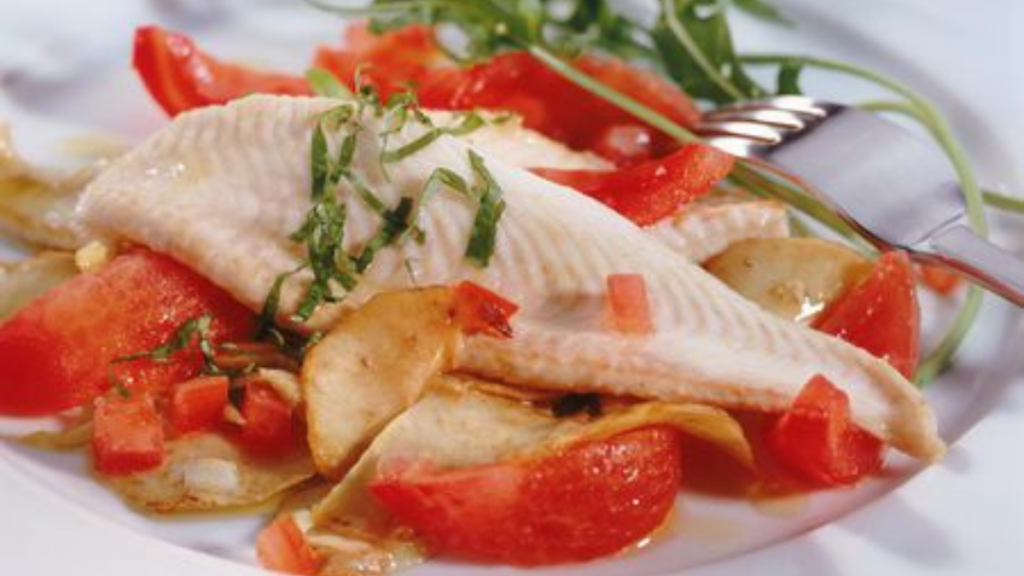You should simmer your poaching liquid at a low temperature. Make sure your pan has enough liquid to cover the fish completely—Cook for 5 minutes after adding the seasoned fish fillets. Remove the pot from the heat and cover it for 10 minutes to allow the fish to finish cooking. The best cooking temperature for poaching trout is around 160°F to 170°F (71°C to 77°C).
The simplest method to determine whether your fish is done is to test it with a fork at an angle, in the thickest part, and gently twist it. When the fish is finished, it will flake easily and lose its transparency or raw appearance.Cooking the fish to an internal temperature of 140-145 degrees is a good rule of thumb.
Trout Nutrition Facts
What Is Trout?
Trout are part of the family Salmonidae, which is in the order Salmoniformes. Most of them only live in fresh water, but a few species go to the ocean to spawn. Salmon and trout are closely related, and they are popular sport fish that are frequently reared in hatcheries before being released into more livable areas of water. Oncorhynchus and Salvelinus are the two most common genera of trout.
The salmon and several trout species belong to the genus Oncorhynchus, although the genus Salvelinus has some trout species that can be considered chars. Differences in body coloration, the shape of the vomer bone on the roof of the mouth, and the teeth distinguish members of the two genera. On a darker-colored body, chars feature red or cream-colored patches. They are further differentiated by teeth positioned on the head (front) of the vomer rather than the shaft.
What is the Best Temperature for Cooking a Poaching Trout?
Here are the few points by that you can easily understand about the perfect temperature for cooking a poaching trout:
- Ideal range: The best cooking temperature for poaching trout is 160 and 180 degrees Fahrenheit. Whether you’re poaching trout, bass, or other types of fish, you’ll want to ensure the water remains at this temperature.
- Low and slow: The low temperature will protect the trout’s delicate flesh from overcooking and help retain its moisturizing and flavor. Once you’ve got your poaching temperature just right, you’ll have a perfect fish.
- Poaching procedure: Poaching is the process of slowly cooking food in a liquid until it is tender and succulent. When done correctly, it produces a moist and tender meal that is delicious and healthy.
- Near-Boiling: While poaching requires a lot of patience and finesse, the results are worth it. This technique is not for everyone, but if you are confident in your skills and are willing to spend the time, it will yield delicious results.
- Preserves Moisture and Flavor: Using water that is near a boil is ideal for this method. The water should cool down to a moderate poaching temperature before adding the food.
- Soft and Gentle: Unlike traditional cooking temperatures, this approach is soft and perfect for delicate fish. Both flavour and moisture will be kept. The most admirable aspect is that the water will be warm enough to cook the fish and serve it properly.
- Water usage: The water used in the no-cook method is near-boiling hot before cooling to a moderate poaching temperature. This approach preserves the moisture and flavor of the fish. It’s also a good choice for frying small, fragile seafood like smelts. If you follow these steps, you will have nicely cooked fish.
- Do Not Exceed 210°F: The water temperature should never exceed 210 degrees, as that will lead to drying out.
Most of the time, you should poach trout when the water is between 160 and 180 degrees Fahrenheit. The ideal temperature for poaching fish is right now. When employing the no-cook approach, you should keep the water temperature below 140 degrees.
It will keep your fish from becoming overcooked. Your fish will not be cooked through if the temperature is too high. For poaching fish, the ideal cooking temperature is the one that meets your preferences.
Some Tips To Poaching Trout
Start With The Right Liquid
Poaching with broth is light and pleasant, whereas poaching with oil or butter results in incredibly soft fillets. Other common ingredients, such as coconut milk or wine, can also be poaching liquids. (Please note that each of the following recipes utilizes a different poaching liquid.)
Build Flavor With Aromatic Vegetables, Herbs, And Spices
Before adding the liquid, sauté aromatic veggies in the pan to create depth. To increase the flavor of your poaching liquor, add herbs, spices, and condiments such as soy sauce and vinegar.
Poaching Isn’t The Same As Boiling.
If you allow the liquid to boil, your fish will become tough. The liquid you’ll use to poach should be heated to a low simmer. Make sure your pan has enough liquid to cover the fish completely. Combine your favorite sort of fish (barramundi, right) with these five poaching liquids and herbs. Each 12-inch skillet or saucepan will give enough liquid to poach four 4- to 6-ounce fillets.
Is Trout Good for You?
Trout live in North America’s rivers and lakes with cold water. Like its relative salmon, trout is a native species. Although there are many other types of trout, rainbow trout is the most common on restaurant menus and at fish markets.
Trout is a nutrient-dense food low in mercury and offers a range of health advantages, making it a healthy addition to your diet.
Vitamins In Trout
Minerals In Trout
A serving of trout also contains a variety of minerals. Potassium, with 11 percent of the daily value, phosphorus, with 23 percent, and selenium, with 34 percent, are the most notable.
Potassium is an electrolyte that aids in fluid equilibrium and adds to nerve function and muscular contraction, whereas phosphorus promotes strong bones and teeth. The trace mineral selenium exhibits antioxidant activity, protecting cells from free radical damage.
What Is The Health Benefits Of Trout?
The Environmental Defense Fund recommends eating four or more servings of trout per month since it is low in mercury. This neurotoxin is especially dangerous to pregnant women and small children. You can also include cold-water fish like mackerel, sardines, and salmon in the mix. The whole trout cooks well on an outdoor grill,
but if you don’t want to deal with the head, you can buy your fish filleted and cook it indoors. Brush it with olive oil, then sprinkle it with a mixture of fresh herbs such as chopped chives, garlic, parsley, and black pepper before baking it. Serve with sliced lemon or lime to enhance the fish’s mild flavor.
Conclusion
The best cooking temperature for poaching trout is 160-180 degrees Fahrenheit. If you prefer to cook it at a higher temperature, you can use the no-cook method. This method uses a pot that starts at a high temperature and slowly cools down to the perfect poaching temperature. When using this method, make sure the water stays between 180 and 185 degrees and avoid letting the water boil too long.



